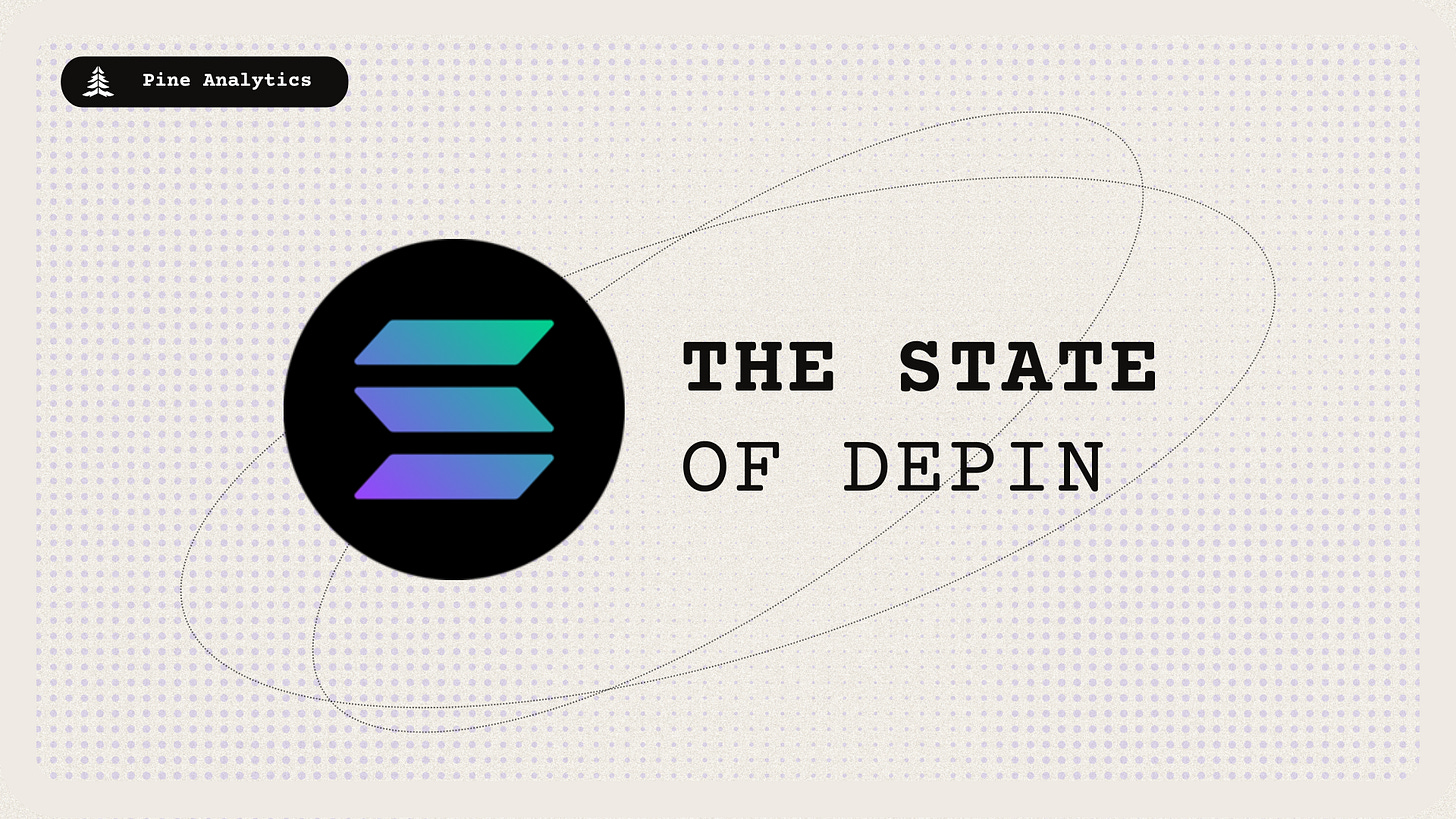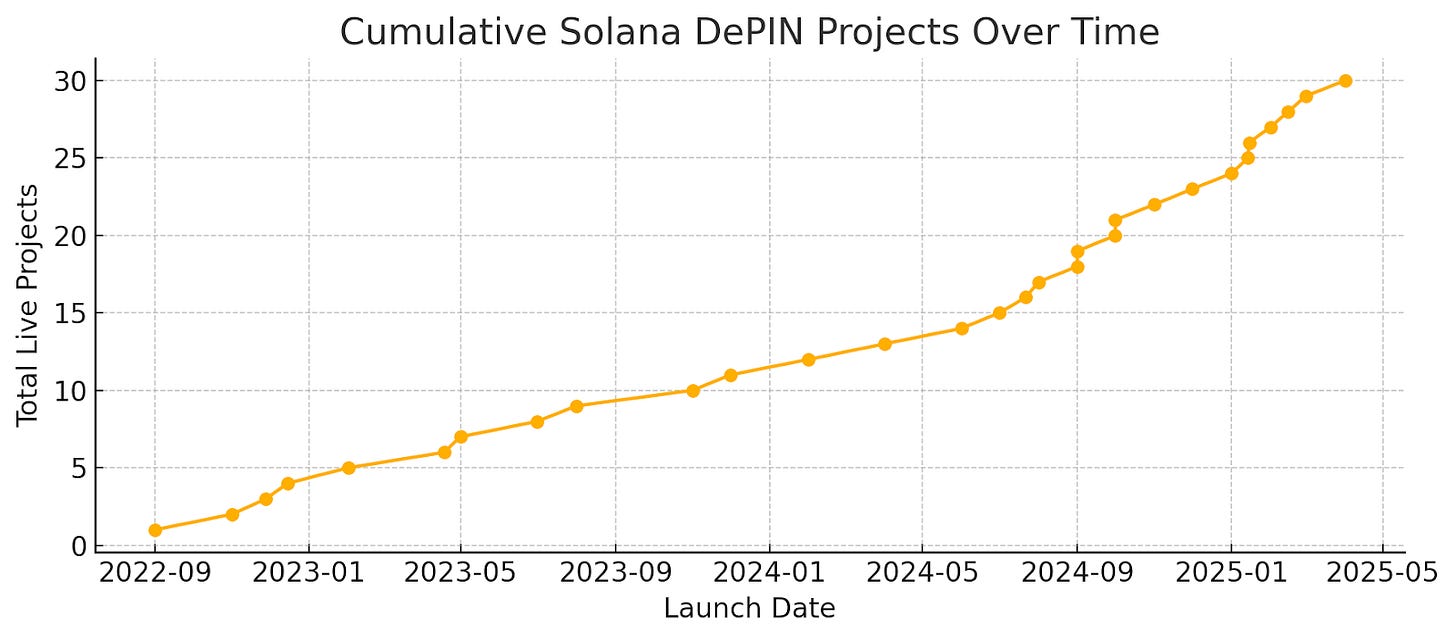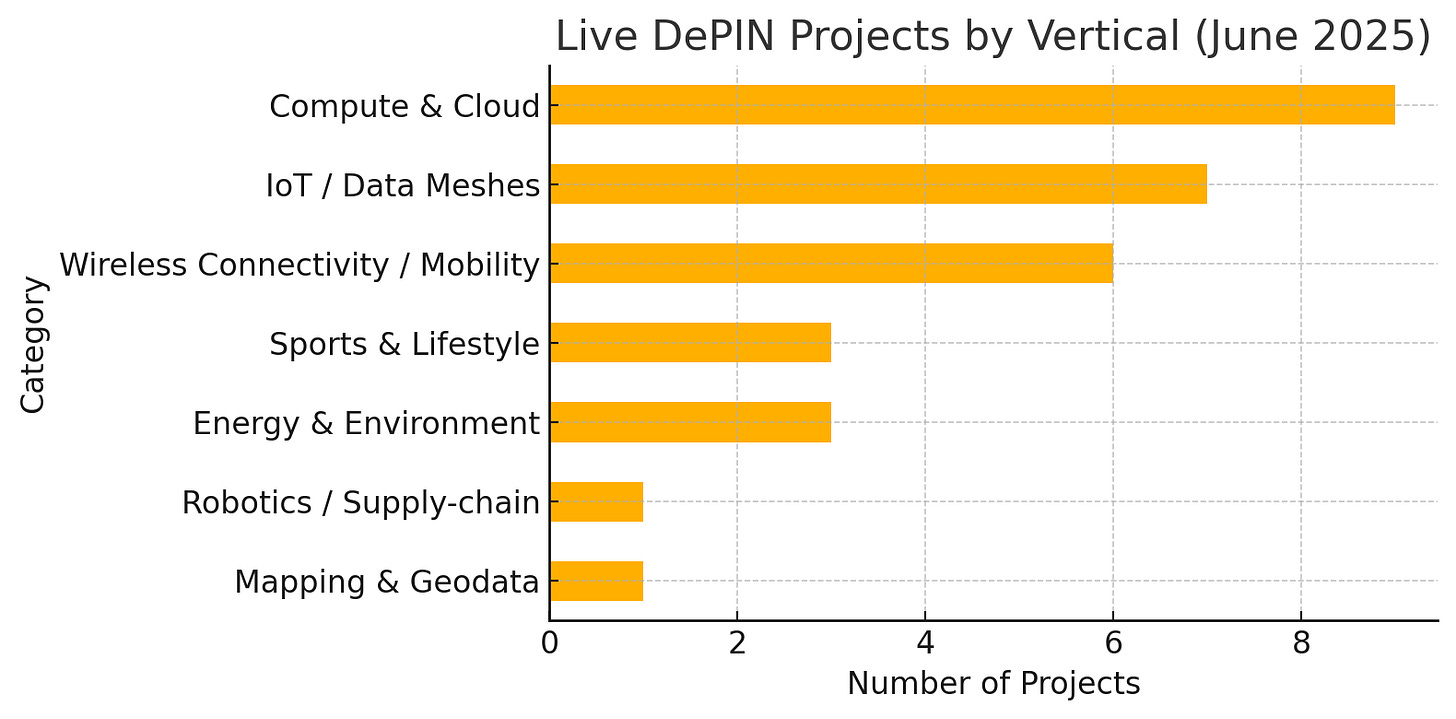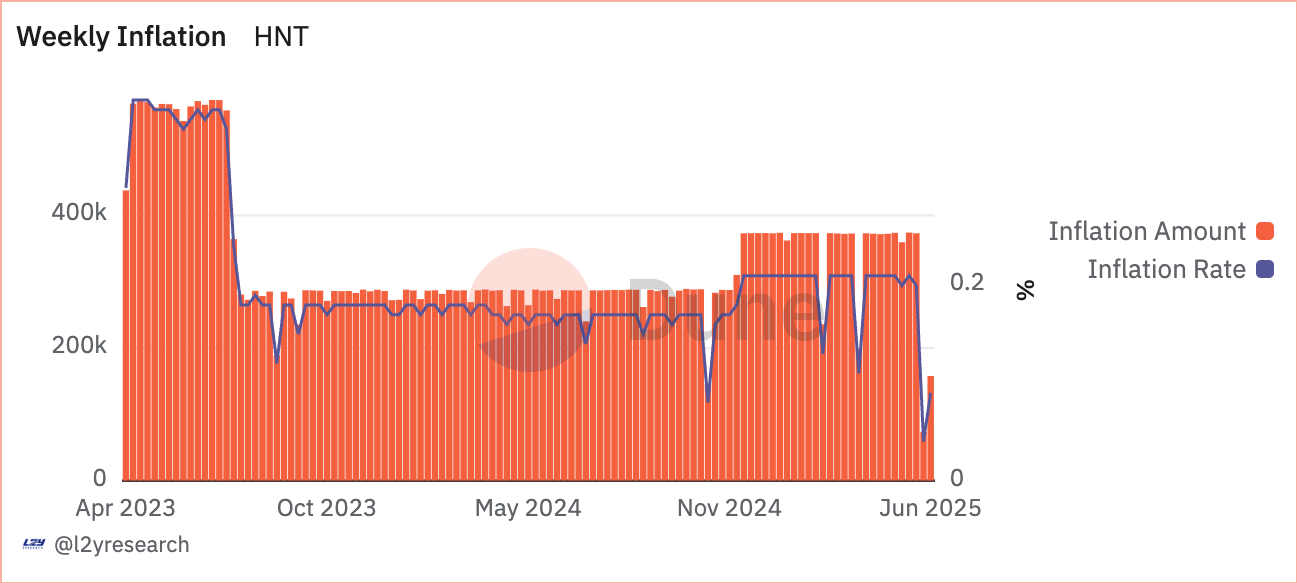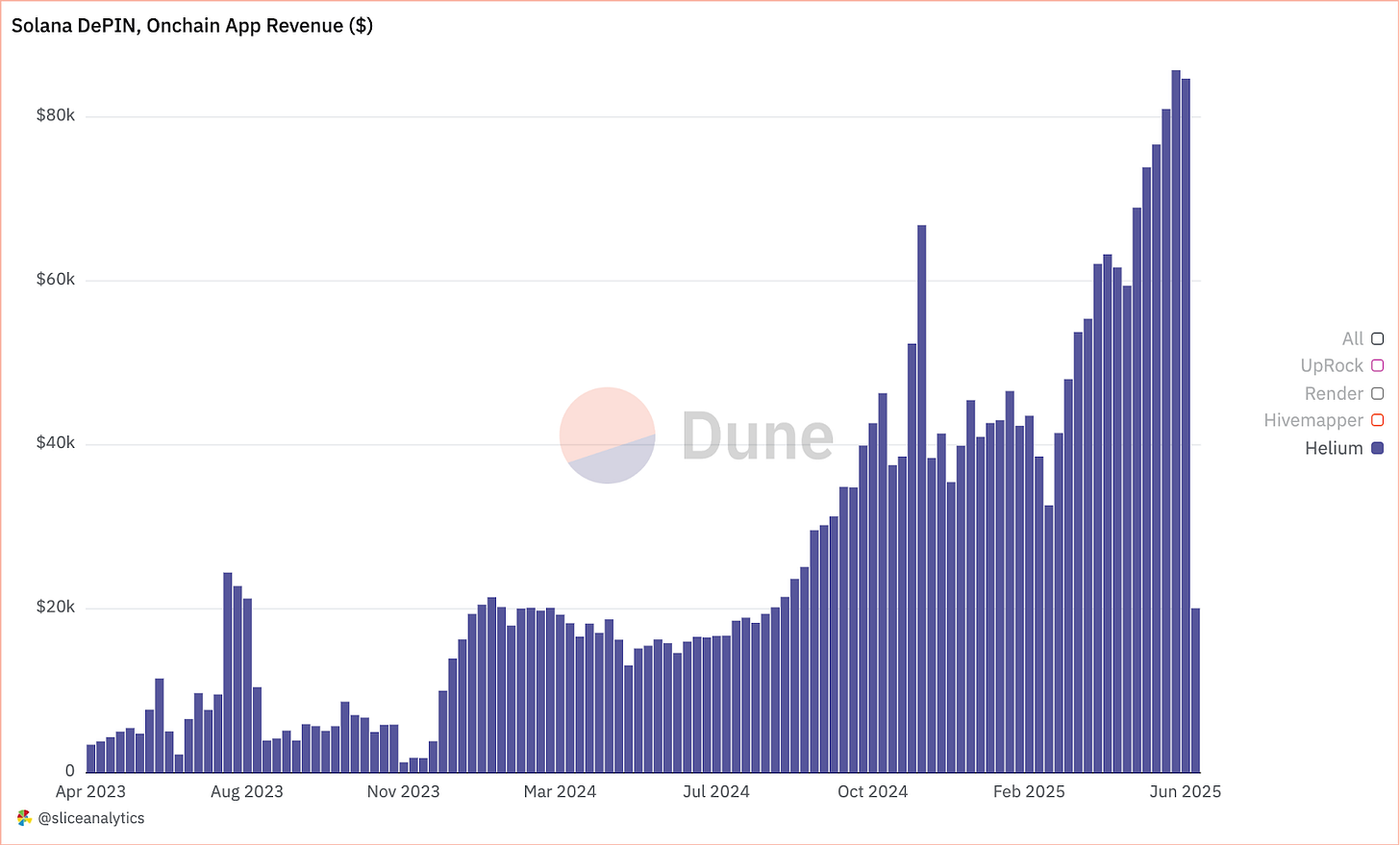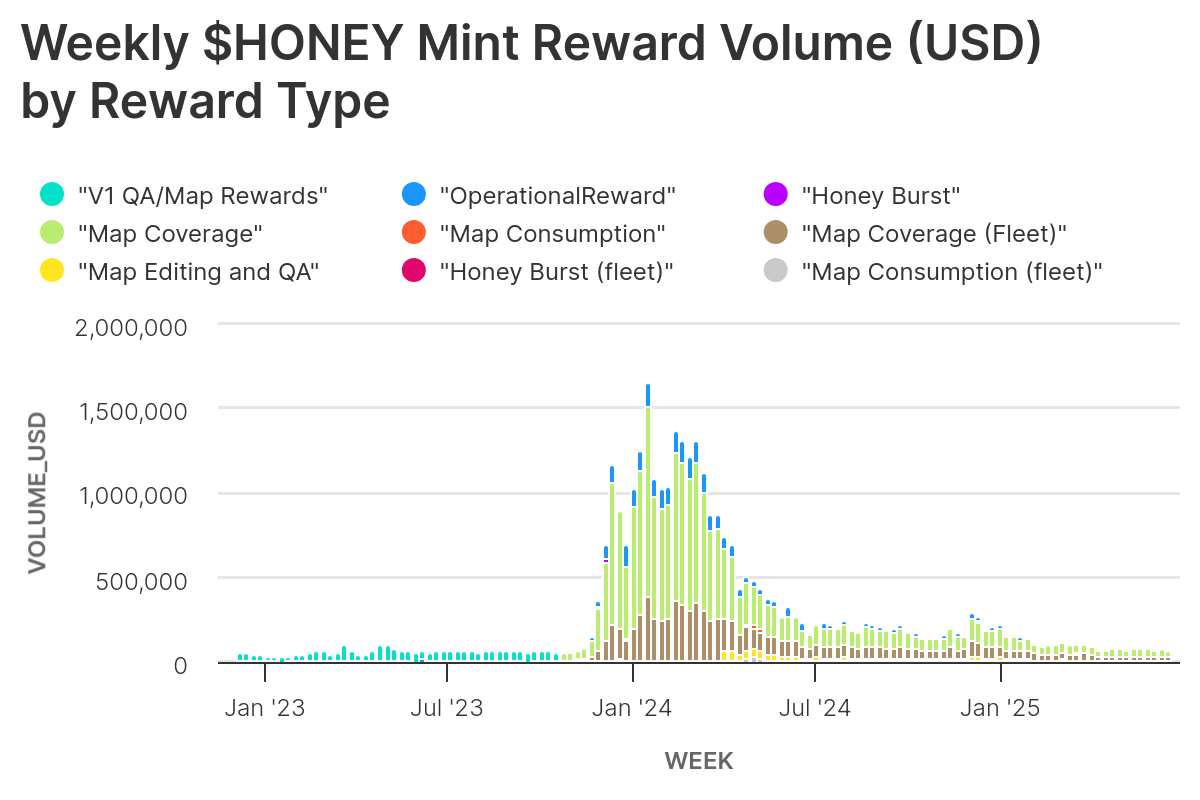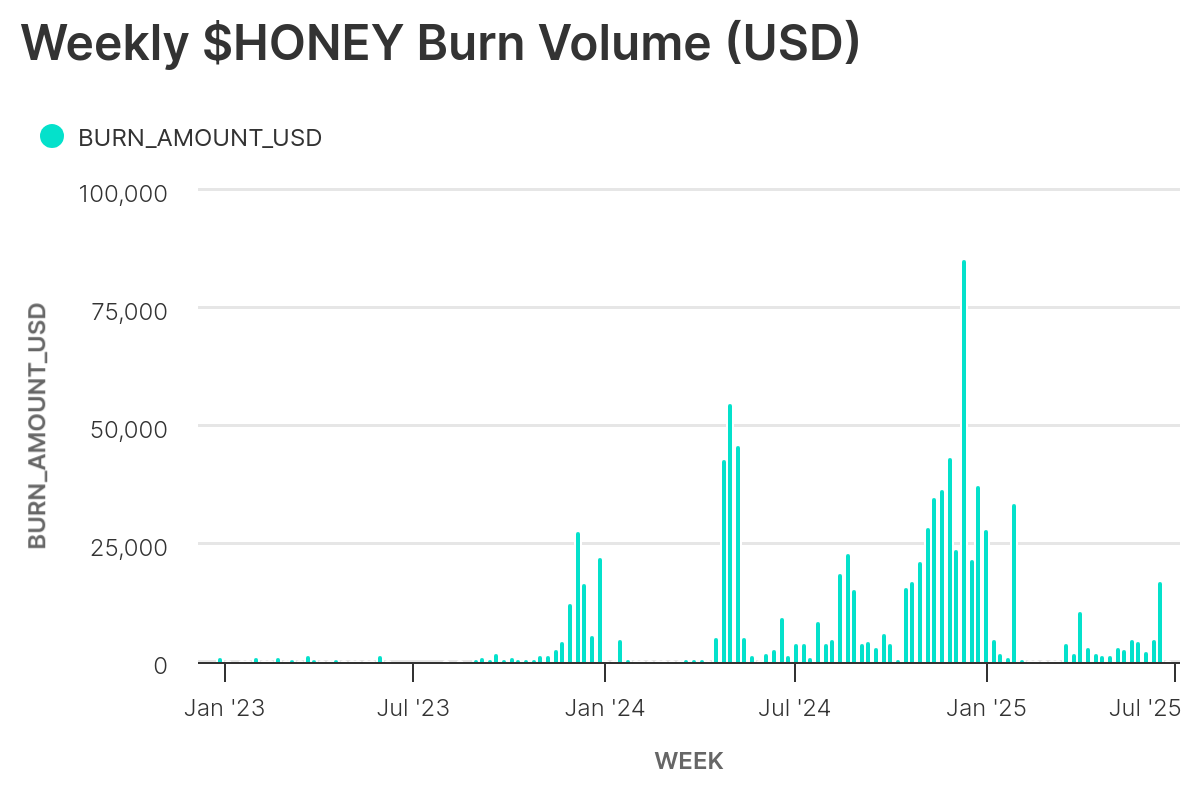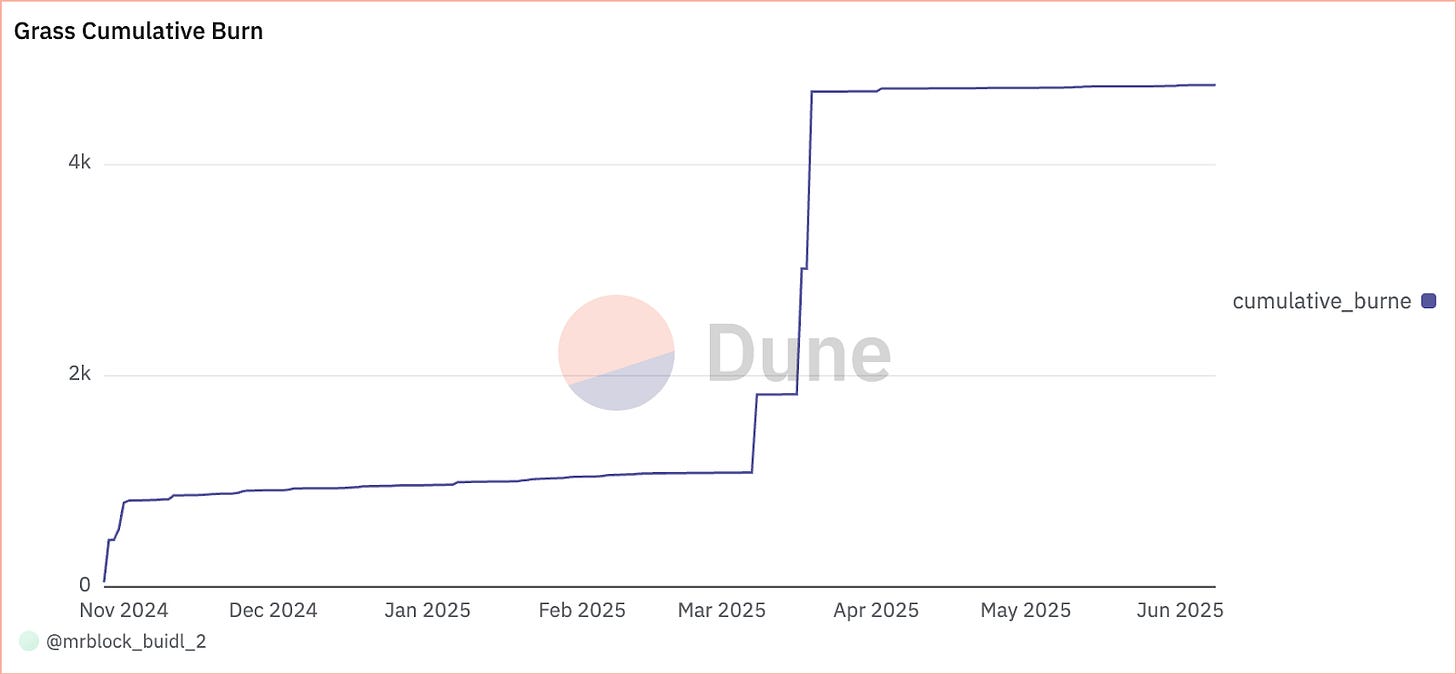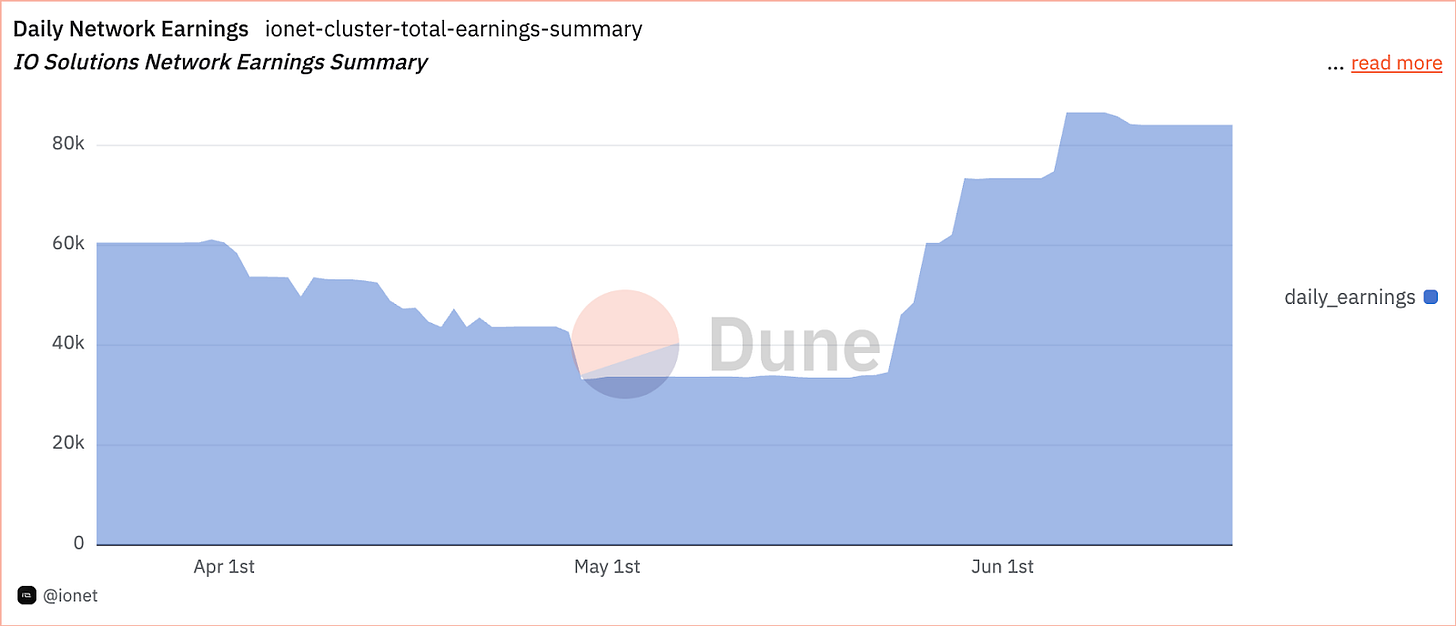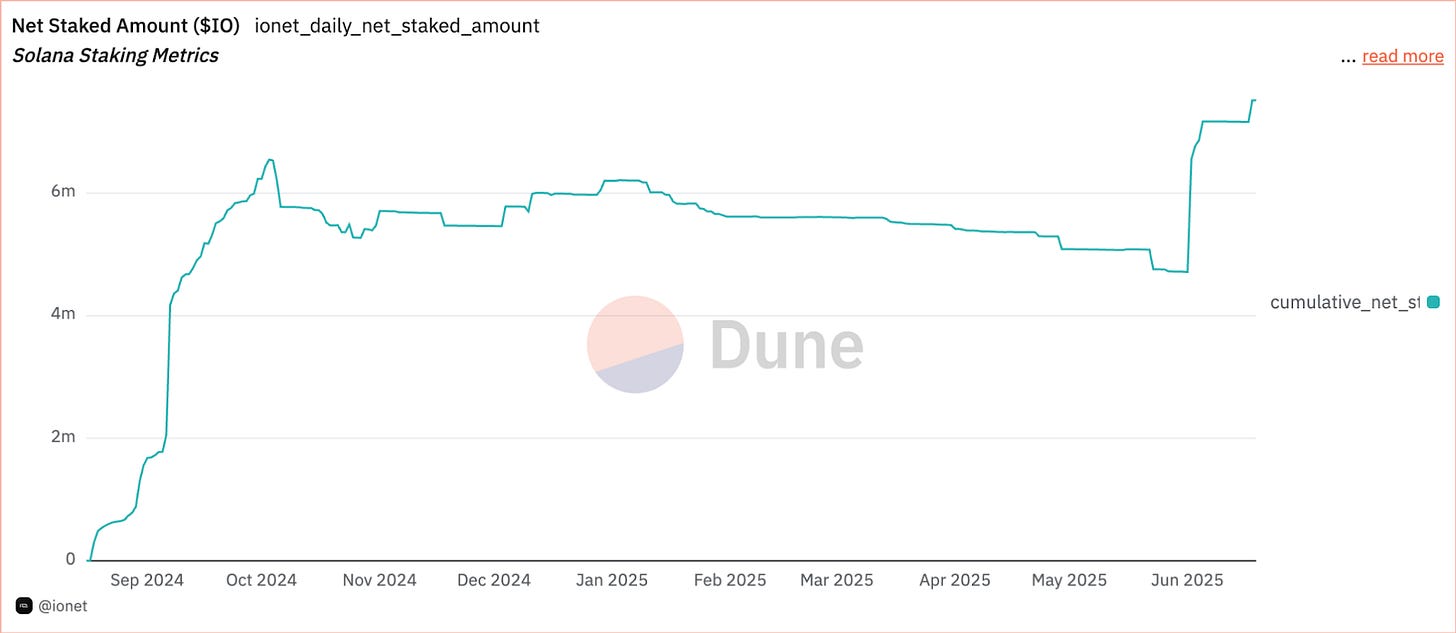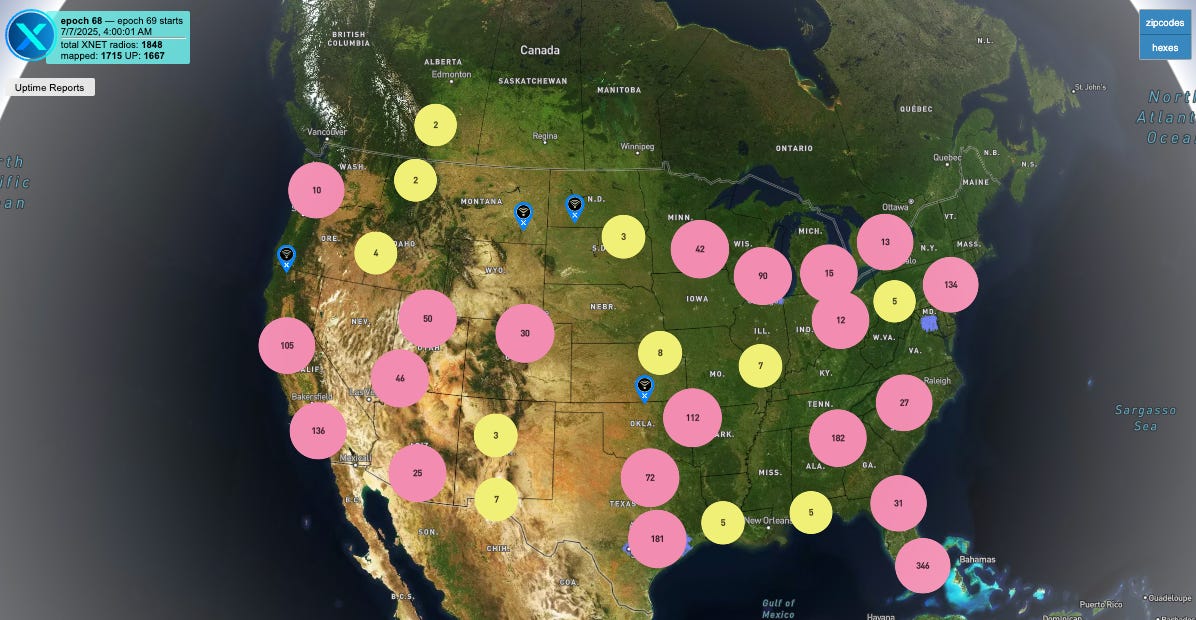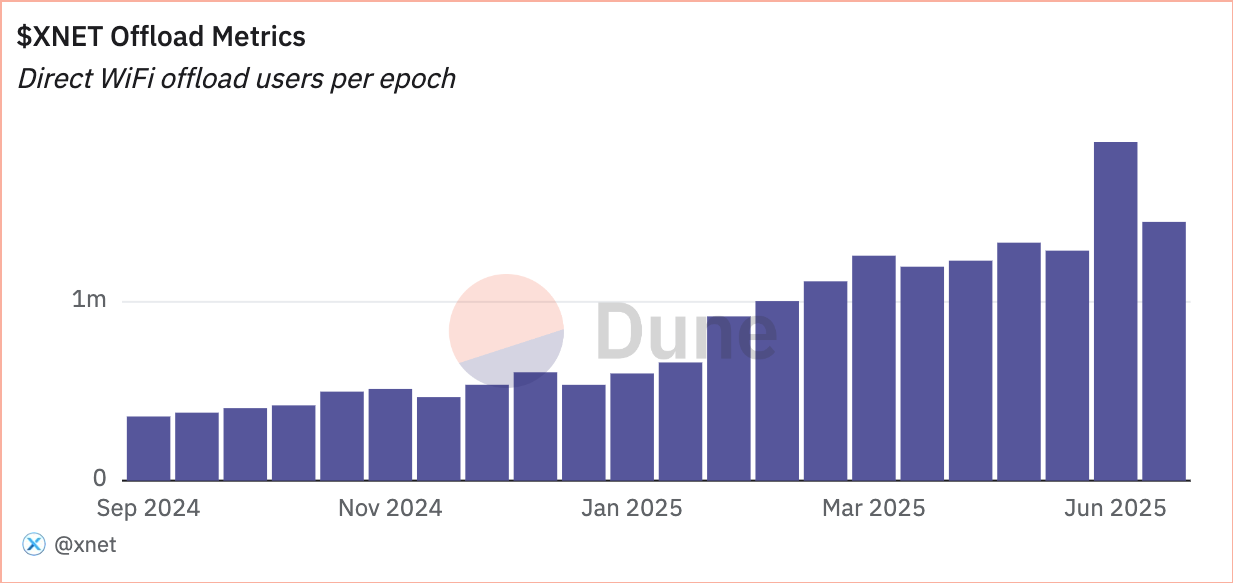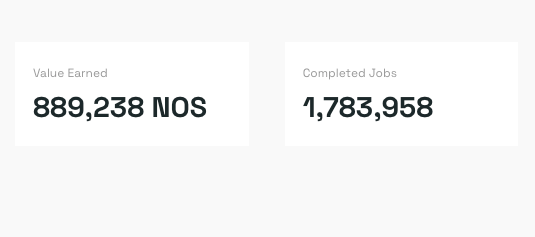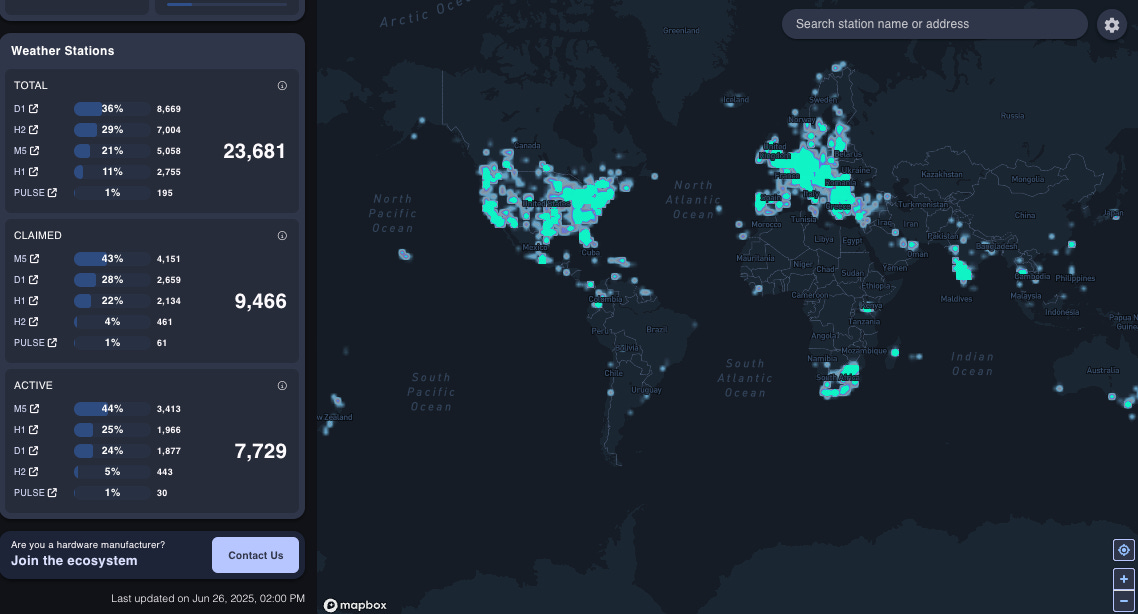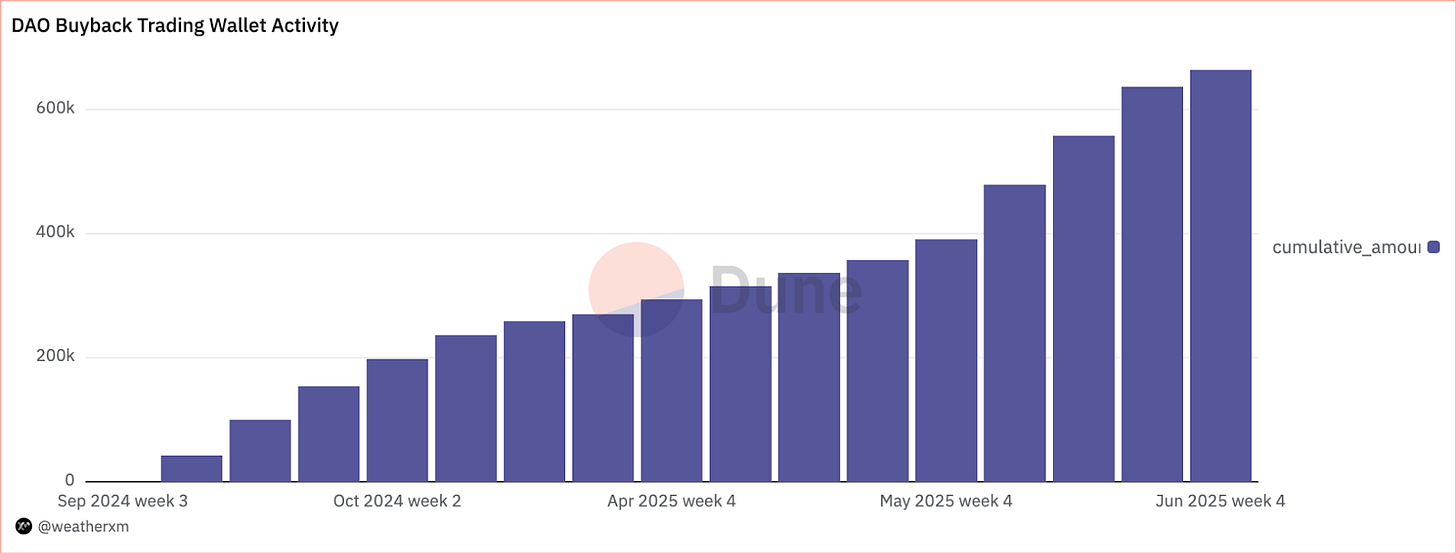Executive Summary
The State of DePIN on Solana: A Market Assessment
Decentralized Physical Infrastructure Networks (DePIN) represent one of crypto's most promising real-world applications, with Solana emerging as a popular choice for many projects due to its technical strengths and liquidity advantages. This report analyzes the current DePIN landscape on Solana, examining network growth, enterprise adoption, technical infrastructure, and strategic patterns to understand why builders are choosing Solana—and what differentiates successful projects.
Market Growth Snapshot
The numbers tell a compelling growth story. Solana hosts 30 active DePIN networks spanning compute, wireless, IoT, mapping, and energy verticals, a six-fold increase from fewer than 5 networks in mid-2023. This expansion reflects broader momentum in real-world blockchain adoption, with Solana as a frequently chosen settlement layer.
Key networks are achieving meaningful scale: Helium operates 370,000 active hotspots across IoT and mobile networks; io.net coordinates 10,000 GPU nodes processing $80,000 in daily compute jobs; Grass has grown to 2-3 million bandwidth-sharing nodes; and Hivemapper has mapped 33% of global roads through crowdsourced dashcam data.
Enterprise Adoption Reality
Perhaps most significantly, major enterprises are integrating DePIN services into their operations. AT&T routes traffic for 18 million devices through XNET's Wi-Fi mesh, processing a total of 176 terabytes so far. Lyft has adopted Hivemapper's Bee Maps for real-time navigation. T-Mobile partners with Helium for IoT roaming services, driving 88,000 HNT in weekly token burns. These partnerships demonstrate that DePIN has moved beyond experimental phases to deliver production-grade infrastructure.
Solana's Technical Foundation
Several technical factors explain Solana's DePIN dominance. Transaction costs of approximately $0.0005 make IoT data processing, frequent reward distributions, and token burn mechanisms economically viable at scale. Additionally, Solana's mature DeFi ecosystem—including Token-2022 standards, compressed accounts, and deep AMM liquidity—reduces development complexity compared to alternative platforms. Beyond technical capabilities, Solana benefits from the strongest current user network effects in crypto, with higher wallet adoption and transaction volumes that provide superior liquidity and distribution for new DePIN tokens.
Winning Network Characteristics
Winning Solana DePINs follow four core moves. First, they target inherently compounding services—Wi-Fi meshes, dash-cams, GPU grids, weather sensors—where every added node lifts overall utility. Second, they deploy generous but surgical early-stage rewards: emissions are calibrated to fund the initial rollout and are channeled toward nodes that raise coverage quality, not just raw count. Third, they secure marquee customers (AT&T, Lyft, Binance) whose demand turns network output into steady cash flow. Finally, they wire in on-chain proofs that link every verified unit of work to a burn, buy-back, or staking sink, permanently binding real usage to token economics.
Looking Forward
This assessment examines whether Solana's advantages are sustainable as competing platforms mature, what strategic frameworks separate durable networks from unsustainable experiments, and how the next wave of DePIN projects can build on current successes while avoiding common pitfalls
Sector Growth & Current Footprint
Solana has emerged as one of the leading launchpads for DePIN, particularly among teams prioritizing high-frequency transactions and deep DeFi integration: the number of main-net DePIN networks has climbed from fewer than five in May 2023 to thirty today, spanning Seven verticals. Because every proof, reward, and buy-and-burn event costs only ~$0.0005 and finalizes in ~400 ms, teams can reward contributors (hotspots, GPUs, sensors, dash-cams) in real time without batching or roll-ups. The result is a steady drumbeat of new deployments-roughly one fresh network every three weeks for the past two years.
Current vertical mix (live project count):
Compute & Cloud - 9
io.net · Nosana · Aethir · Render Network · DRPC · DAWN · Beamable Network · ZkAGI · Shadow DriveIoT / Data Meshes - 7
Grass · 375ai · Aydo · UpRock · WeatherXM · GEODNET · Street MintWireless Connectivity / Mobility - 6
Helium · Wireless XNET · Dabba Network · Roam · END Corp · TeleportEnergy & Environment - 3
Powerledger · Starpower · KuzcoMapping & Geodata - 2
Hivemapper · GEODNET (GEODNET spans both IoT sensing and centimeter-level mapping)Sports & Lifestyle - 3
Stepn · Genopets · CudisRobotics / Supply-chain - 1
dVIN
Network Scale & Growth Snapshots (mid-2025)
Helium - ≈ 370K active hotspots (279K IoT + 97K Mobile) and still adding ±1K units/week. Weekly Data-Credit burns now average 88K HNT, up 3× since early-2024.
Grass - Residential-proxy swarm has reached 2-3 million nodes across 190 countries, versus ~600K only a year ago; daily bandwidth served has climbed from 10 TB (Q1 2024) to roughly 90 TB today.
WeatherXM - Live station count grew from 1K (Sept 2023) to 7k+; WXM burn for data licences rose from near-zero to ≈ 660K WXM total (~$120k) in nine months.
Nosana - From <100 test GPUs in late-2023 to 5K staked GPUs today; hosts collectively earn 54K NOS/day in inflation plus job fees, with utilisation climbing every month.
io.net - Pledged compute has expanded to ≈ 450 PFLOPS and 10K nodes, processing ≈ $80K in GPU jobs each day, up from <$10k/day at main-net launch (Jan 2024).
XNET - Hotspot mesh now routes 176 TB for 18 million devices every two-week epoch-more than quadruple early-2024 traffic-after April 2025’s AT&T off-load rollout.
Institutional customers
Institutional cash-flow is now coursing through Solana's DePIN stack:
Wireless & Connectivity
AT&T off-loads mobile traffic onto XNET hotspots, driving four-fold growth and routing Wi-Fi for 18 million devices every two-week epoch
Helium secures roaming back-end from T-Mobile US and multiple smart-city integrators, burning roughly 88K HNT each week as IoT and 5G data credits
Mapping & Geodata
Hivemapper serves map buyers including Lyft, HERE, TomTom and Maxar who burn HONEY for fresh street-view imagery, with weekly burn peaks of up to $40k
Compute & Cloud
io.net processes $80K per day from Binance Launchpool and AI start-ups for GPU hours
Nosana handles 20K-40K jobs daily through partnerships with Render Network and cloud provider PiKNiK
Energy & Data
Powerledger enables regulated Australian utilities to clear peer-to-peer energy trades
WeatherXM has burned 660K WXM from agritech, crop-insurance and mobility fleets for hyper-local weather feeds
Together these anchor customers convert token emissions into verifiable revenue and give DePIN networks the commercial credibility they previously lacked.
Geographic Spread & Regulatory Hot-Spots
North America and Western Europe still host the densest DePIN coverage-Helium’s 5 G and XNET’s Wi-Fi clusters in Florida, California, Texas, and NYC; io.net/Nosana’s highest-end GPUs in the U.S. and EU; Hivemapper’s dash-cam uploads dominated by U.S. drivers. Yet the fastest node growth is shifting to India, Southeast Asia, Brazil, and parts of Africa, where WeatherXM stations, Grass proxy nodes, and GEODNET reference antennas fill glaring infrastructure gaps. Three friction points loom: (1) Spectrum & telecom rules-U.S. CBRS and EU licence fees cap 5 G roll-outs; (2) Data-privacy regimes-EU dash-cam and residential-proxy consent laws could trim European contributions; and (3) IoT import tariffs-hardware duties in India and Brazil raise the break-even for weather stations and smart-meters. Projects that navigate these regional constraints-often by partnering with incumbents like AT&T (XNET) or local utilities (Powerledger)-are scaling fastest and setting the regulatory blueprint for the next wave of DePIN expansion.
Helium
Overview
The Helium Network powers two distinct wireless networks; a global LoRaWAN network for IoT devices, and a cellular offload Wi-Fi network for mobile connectivity. Wireless gateways called "Hotspots", operated by the Helium community, provide the coverage for these networks. Hotspot owners are incentivized with the Helium HNT token for providing coverage and handling wireless traffic.
Project Timeline
Jul 2019 - Helium launches its original LoRaWAN network and HNT token on its own Layer 1 blockchain.
2020-2021 - Rapid global hotspot growth; LoRaWAN Hotspots deployed across 160+ countries.
Aug 2021 - Helium announces plans to expand beyond IoT into 5G infrastructure via the Helium 5G initiative.
Sep 2022 - Helium Foundation proposes HIP-70 to migrate the network to Solana for greater scalability and DeFi integration.
Mar 2023 - Migration to Solana completed; HNT, IOT, and MOBILE tokens now live as SPL assets.
2023-2024 - 5G Hotspot rollout expands in the U.S., with hundreds of operators supporting CBRS-based wireless coverage.
Mar 2024 - Helium announces commercial partnerships in logistics and smart city deployments using the LoRaWAN network.
Network Supply Side
As reported on the Helium website, there are currently 97K Helium Mobile hotspots and 279K IoT hotspots. The Mobile network has very high density in North America, while the IoT network is more broadly distributed, with significant presence in Europe as well. At present, the network emits approximately $818K per week in tokens supporting continued growth and participation across both the IoT and Mobile ecosystems.
Network Demand Side
Helium generates on-chain revenue through a burn-and-mint model that ties real-world wireless usage directly to token burns. Users convert HNT into Data Credits (DCs), which are required to transmit data on the network. Mobile data is priced at $0.50 per gigabyte (50K DCs), while IoT usage is billed per 24-byte message increment. This structure ensures that every byte of data transmitted on the network corresponds to on-chain activity. Currently, the network burns around 88k HNT per week-a number that is on a strong and sustained uptrend. As usage grows, more HNT is permanently removed from circulation, directly linking service demand to token scarcity.
Use of Solana
Helium uses Solana to manage its token ecosystem (HNT, MOBILE, and IOT) and to represent each hotspot device as an on-chain NFT. These NFTs uniquely identify IoT and Mobile hotspots, enabling the network to track ownership, reward eligibility, and transfers natively on Solana. All token emissions, Data Credit burns, and staking mechanics are executed via Solana smart contracts. The network migrated from its own custom L1 to Solana in early 2023 to gain scalability, lower costs, and broader ecosystem support-making Solana a practical and efficient foundation for powering Helium’s global wireless infrastructure.
Hive mapper
Overview
Hivemapper is a DePIN project that turns everyday drivers into contributors to a global map. Drivers install specialized dashcams and earn HONEY tokens for uploading fresh street-level imagery as they drive. The data they generate is processed and packaged-under the Bee Maps brand-for use in navigation, mobility, and logistics. Companies like Lyft and others can purchase this map data by buying and burning HONEY tokens, creating a closed-loop economy between contributors and data consumers.
Project Timeline
2022 - Mainnet launches on Solana; HONEY token (4 B cap) begins distribution; first production dashcams ship.
2023 - Network grows to 3K - 12K weekly active mappers.
Feb 2024 - Next-gen “Bee” dashcam unveiled for mass-market and fleet use.
Sep 2024 - Bee Maps brand launches; coverage reaches 26 % of global roads (~10 M unique miles).
14 May 2025 - Lyft signs on to use Bee Maps for real-time ride-hailing navigation.
Jun 2025 - Maxar × Bee Maps integrate satellite change-detection with street-level verification.
Network Supply Side
Currently, around 7K wallets receive HONEY driver map coverage rewards each week, while approximately 300 wallets earn rewards for curating map data. In total, these network participants earn about $80K per week for their contributions. So far, these mappers and editors have managed to cover 33% of the world’s road distance and provide some of the freshest street-level data available.
Network Demand Side
Each week, between $1K and $3K worth of HONEY is burned to consume Hivemapper data by around 10 wallets. In late 2024, there was a 2.5-month stretch where weekly burns ranged from $15K to $40k, driven by network usage from hundreds of wallets. Current customers include Lyft, HERE Technologies, TomTom, and Maxar.
Use of Solana
Hivemapper uses Solana to distribute its HONEY token to contributors but does not use the chain for attestation or node tracking. The network effects of the Solana ecosystem-combined with robust DeFi infrastructure and low transaction fees-make it one of the few viable chains for issuing high-volume, low-value rewards in a native token.
Grass
Overview
Grass turns any laptop, phone, or router into a residential proxy node. When you install the Grass browser extension or app, you “rent out” a slice of your idle internet bandwidth. Enterprise customers use that bandwidth to pull public-web pages in real time-mainly to feed AI models, run price-intelligence crawlers, or test ad-fraud defenses.
Project TImeline
Q4 2023 - Grass announces its vision for a decentralized bandwidth-sharing network and begins onboarding early users via browser extension.
Jan 2024 - GRASS token officially launched on Solana with initial supply and airdrop plans.
Q1 2024 - Active node count surpasses 600K; daily bandwidth usage crosses 10 TB.
Oct 2024 - First GRASS airdrop distributed to over 1.5 million wallets.
Feb 2025 - Daily scraping throughput exceeds 1 million GB; node network spans over 190 countries.
May 2025 - Second GRASS airdrop completed; over 3 million active nodes reported.
Jun 2025 - Grasshopper hardware unveiled: the first dedicated device for the Grass Network. Limited units;
Network Supply Side
Official statements and analyses report 2-3 million active nodes contributing bandwidth across ~190 countries. In total these nodes currently provide on the order of 100+ Gbps of scraping throughput, Messari reports “daily data collection volumes approaching 90 TB” as of mid-2025. Grass rewards operators with “Grass Points” (later convertible to GRASS tokens), in total there has been 6.5M Grass claims worth nearly $8M.
Network Demand Side
Clients use Grass as a “residential proxy” network. businesses use Grass to test localized ads, compare regional prices, track weather data, train AI models, etc., all via ordinary user connections. The LifeTIme Grass Burn Volume is just over $5K lifetime which is drastically under the value distributed to the supply side.
Use of Solana
Grass uses Solana to distribute its GRASS token to contributors, manage staking for routers, and record slashing events tied to network performance. While raw data stays off-chain, Solana tracks token flows and on-chain proofs. Routers-special nodes that help coordinate data traffic-are required to stake GRASS, which can be slashed if they misbehave or fail uptime checks. This staking mechanism aligns incentives and helps secure the system without relying on heavy infrastructure. The speed, low fees, and robust DeFi tooling in the Solana ecosystem make it well-suited for handling millions of micro-rewards and coordinating decentralized traffic infrastructure at scale.
Io.net
Overview
Io.net is a DePIN project that builds a decentralized compute network by aggregating underutilized GPUs from individuals, data centers, and institutions. Node operators contribute GPU resources by connecting through the Io.net stack and earn rewards in the native IO token. On the demand side, developers and companies can rent this compute-primarily for AI training and inference-at lower cost than centralized providers. Io.net abstracts thousands of distributed GPUs into a unified platform, allowing users to spin up clusters with GPU-specific configurations. The system is built on Solana, enabling high-frequency token rewards, staking, and payment settlement while keeping compute coordination off-chain.
Project Timeline
Nov 2023 - Beta launch of the decentralized GPU network; incentive program announced, attracting >107K GPUs on the wait-list.
Jan 2024 - Ignition program rolls out to reward early GPU suppliers and community contributors.
Mar 2024 - Raises $30 M Series A at a $1B FDV to scale the “Internet of GPUs.”
28 Apr 2024 - First IO token TGE; early allocations distributed to beta participants.
7 - 11 Jun 2024 - Binance Launchpool farm (Jun 7) and main token listing (Jun 11) release 95 M IO; listing price $3.74.
Q4 2024 - Network exceeds 600 petaFLOPS of pledged compute and begins commercial AI-training clusters (internal update).
Feb 2025 - Active fleet tops 10K GPU nodes across 190 countries, delivering ≈450 petaFLOPS and processing $12 M/month in jobs.
17 Jun 2025 - Io.net Foundation launches a $20 M IO Grant Program to fund builders and provide free GPU hours.
Network Supply Side
The Io.net grid currently delivers ≈ 20K GPU/CPU hours per day, with lifetime usage passing 16 million hours. These jobs are handled by roughly 7K fully-staked GPUs/CPUs, each bonded with at least 200 IO per device (higher for H100/A100-class cards). Together they provide a peak capacity of ≈ 450 petaFLOPS across 190 countries. Hardware mix skews enterprise-grade-about 40 % Nvidia A/H-series, 35 % RTX-30, and the balance RTX-20 or consumer GPUs-giving customers flexible options for both training and inference. At today’s demand levels this translates to ~18-20 % fleet utilisation, leaving headroom for new workloads.
Network Demand Side
Io.net’s Dashboard show Io.net now clears roughly $80K in job payments every day, with cumulative protocol fees surpassing $14.5 M since launch-both metrics trending steadily upward. The spend is coming from a mix of AI-focused customers: independent ML researchers fine-tuning open-source LLMs, generative-media startups running Stable-Diffusion-style workloads, Web3 teams that need short-burst GPU batches for zk-proof generation, and a handful of enterprise pilots in ad-tech and biotech that require large distributed inference clusters. In every case the customer converts fiat or USDC into IO, which then flows to GPU suppliers.
Use of Solana
Io.net uses Solana to mint and distribute its IO token, enforce per-device staking, and log fee burns tied to completed compute jobs. GPU and CPU providers must stake IO on-chain; that collateral can be slashed if a node goes offline or submits invalid proofs, keeping the fleet reliable without heavy oversight. Customer payments-whether in IO, USDC, or fiat-settle through Solana smart contracts, which automatically route rewards to suppliers and burn the protocol fee. Solana’s high throughput, sub-cent fees, and deep DeFi liquidity let Io.net handle thousands of micro-payouts per minute and give participants instant options to swap, restake, or leverage their earnings at scale.
XNet
Overview
XNET is a Solana-native DePIN project that crowdsources enterprise-grade Wi-Fi coverage. Venue owners install XNET-branded access points that run custom firmware; each device signs hourly proof-of-coverage and quality-of-service bundles that an oracle batches to Solana. Operators stake and earn the native XNET token, with rewards proportional to verified bandwidth served and uptime. On the demand side, telecoms and large enterprises-most notably AT&T, which integrated XNET in April 2025-pay to off-load mobile traffic onto the hotspot mesh; the USD fees are trustlessly swapped to XNET and streamed to node operators. Solana’s low-fee, sub-second finality lets the network settle thousands of micro-payments and slashing events per epoch while keeping the heavy radio-coordination logic off-chain, allowing XNET to present a single, carrier-grade Wi-Fi fabric built from thousands of independently owned hotspots.
Project Timeline
28 Nov 2022 - Epoch 1: first $XNET hotspot rewards paid to early Wi-Fi/CBRS deployers.
Nov 2023 - HetNet & Foundation launch: production carrier-grade Wi-Fi/CBRS network goes live; 40 % of operator revenue begins automatic buy-&-burn of $XNET.
26 Jul 2024 - $XNET SPL mint: initial token minted on Solana mainnet ahead of full chain migration.
Sep 2024 - AT&T roaming pilot: Tier-1 carrier starts off-loading mobile traffic onto XNET hotspots in test markets.
4 Apr 2025 - AT&T partnership announced: nationwide deal made public; network reports ~688 active nodes and ~9 million user connections.
12 May 2025 - Native staking live: Solana-based $XNET staking contract launches, offering up to ≈22 % APY for year-long locks.
Network Supply Side
There are currently 782 active Tier-1 XNET Wi-Fi nodes and about 1.7k nodes in total. The network emits roughly 200k $XNET per day (≈ $4k) to fund growth. All nodes are located in the United States, with notable clusters in Florida, Texas, California, and New York City. During each epoch, radios that log 50-75 % uptime receive 50 % of the maximum $XNET CV reward, whereas radios that maintain 99.9 % or higher uptime earn the full amount plus an extra 10 % bonus.
Network Demand Side
XNET has already routed ≈ 176 TB of data for 18 million devices across 94 million Wi-Fi sessions, now averaging just over 1 million users every two-week epoch-up from ~400k in early 2024. Growth is fueled chiefly by AT&T’s nationwide off-load deal, which converts carrier payments into $XNET streams for node operators, and by enterprise venues (stadiums, hotels, campuses) using XNET firmware to cut bandwidth costs while sharing in token rewards. On average the networks notes generate about 150 $XNET per day (≈ $3) in operator earnings.
Use of Solana
XNET’s entire economy runs on Solana. The 2.4 B-cap $XNET SPL token was minted in July 2024, with the old Polygon supply burned after September’s migration. Every two-week epoch a Distributor program batch-mints hotspot rewards from coverage proofs anchored on-chain; radios that misreport or go offline lose part of their staked tokens. Operators can lock $XNET for 90-365 days to boost earnings (~22 % APY), while AT&T’s USD off-load fees are auto-swapped into $XNET-40 % burned, 60 % fed into the next rewards pot. Emissions and burn ratios are governed by a Realms DAO, and Solana’s sub-cent fees plus ~400 ms finality let XNET settle thousands of payouts and burns per epoch while giving operators instant DeFi liquidity.
Nosana
Overview
Nosana is a Solana-native “crowd-GPU” marketplace that lets anyone-from home miners with idle RTX cards to data-centre operators with A/H-series servers-rent out spare compute to AI developers. Node operators install the Nosana client, stake the fixed-supply 1 billion $NOS token, and earn NOS for every validated second of training or inference work. On the demand side, data-scientists push containerised jobs (PyTorch, TensorFlow, Stable-Diffusion, ZK-proof generation, etc.) through a CLI or GraphQL API and pay only for the compute they consume-about 2.5× cheaper than traditional cloud rates, according to 2025 network stats. Solana smart-contracts handle per-device staking, slashing for downtime, micro-payouts every few minutes and an automatic 5 % protocol-fee burn. With sub-second finality and no cross-chain bridges in the critical path, Nosana turns thousands of distributed GPUs into liquid, on-chain infrastructure while giving AI teams scalable compute at a fraction of hyperscale prices.
Project Timeline
10-12 Jan 2022 - token generation event on Solanium and MEXC raises $380k and lists the 100 M-cap $NOS SPL token.
Oct 2023 - team drops CI/CD focus and repositions Nosana as a decentralized GPU grid for AI inference.
Nov 2023 - public test-net launches; >100 GPUs from early hosts complete benchmark jobs and earn 3 M $NOS rewards.
20 Sep 2024 - Chainwire release confirms 14 Jan 2025 main-net target and opens host wait-list.
23 Dec 2024 - blog update reports >1k GPU providers onboarded, staking and pricing models finalized.
14 Jan 2025 - public launch enables on-demand AI jobs; Solana contracts handle staking, slashing, and minute-level $NOS payouts.
Network Supply Side
Since main-net launch, ≈ 5K GPUs have completed at least one job, with 600-800 hosts online at any moment. Hosts receive 95 % of every job fee plus their share of the protocol’s 2 % annual inflation, which mints roughly 54K NOS per day. At the late-June price of ≈ $0.50 NOS, that inflation alone is worth ≈ $27k daily; adding job fees pushes total host earnings toward $25k-plus per day, all paid automatically to the wallets that provide reliable compute.
Network Demand Side
Demand is driven by three cohorts: (1) open-source ML researchers fine-tuning models such as Llama-2 and Stable Diffusion, (2) creative studios running generative-media or RL pipelines, and (3) Web3 teams bursting GPUs for zk-proof generation. Together they submit ≈ 20K-40K containerised jobs each day, generating ≈ 120K on-chain attestations. At an average fee of 0.5 NOS per job, daily spend lands in the $5K-$10K range, and both job count and fee volume have climbed month-over-month since Nosana’s May 2024 growth spurt.
Use of Solana
Nosana routes its entire economy through Solana: the 100 M-cap $NOS SPL token (minted Jan 2022) underpins fees, staking, and rewards . Each AI job is escrowed in the Nosana Jobs program; once a worker posts milestone proofs, the contract releases 95 % of the fee to the host and burns 5 % . GPU providers stake NOS via the Nodes/Staking programs and are auto-slashed for downtime or bad proofs . A protocol emission pool tops up payouts, and upgrade keys (no public DAO yet) let the foundation tweak emission or burn rates. Thanks to Solana’s sub-cent fees and ~400 ms finality, the network can settle roughly 120K attestations and thousands of micro-payouts every day without batching.
WeatherXM
Overview
WeatherXM turns backyard weather stations into nodes of a decentralized climate-data market. Anyone can mount a low-cost WeatherXM sensor, pair it with the network, and earn WXM tokens for streaming high-frequency temperature, humidity, wind, and precipitation data. Each station signs hourly payloads that an oracle scores for uptime and data quality; rewards are minted on Solana and credited to the owner’s wallet. Commercial users-farm-tech platforms, insurers, logistics firms, even ride-hailing apps-secure a paid data-license NFT or spend WXM to query the REST/GraphQL API, creating a closed loop between contributors and buyers. With more than 20K active stations across 90 + countrie, WeatherXM is building the world’s densest hyper-local weather grid while keeping settlement costs at fractions of a cent per sensor report. In effect, the network converts personal weather hardware into an ongoing revenue stream and supplies businesses with real-time, tamper-evident climate data that traditional national weather services can’t match.
Project Timeline
8 Jul 2022 - Seed round: raises $5 M to build crypto-enabled weather stations.
21 Sep 2023 - Explorer + app v2: public map and mobile apps launch; network tops 1K stations.
Nov 2023 - Association formed: Zug-based non-profit established; WXM reward pilot goes live.
30 May 2024 - $WXM token launch: main-net rewards start (Arbitrum), supply bridged to Solana DEXs.
22 Jul 2024 - First Solana data-license sale: >5K stations across 80 + countries; initial enterprise auction clears in WXM.
24 Jan 2025 - Forecast & governance: region-level forecasts ship and first on-chain proposal (WIP-001) passes.
Network Supply Side
WeatherXM has ≈ 7K active weather-station nodes (out of 23 681 registered units), with the densest clusters in the U.S. Midwest/Southeast, Western Europe (Germany, France, U.K.), and emerging pockets in India and southern Africa. The network distributes about 404K $WXM in the last 30 days-roughly 13.5K $WXM (≈ $4k) per day-to station owners, with higher-tier sensors (D1 and H2 models) capturing the bulk of emissions. Rewards scale with uptime and data-quality scores, ensuring that consistently reporting stations earn a larger share of the daily pool.
Network demand side
From September 2024 date, WeatherXM buyers have burned about 660K WXM, worth about $120K for data access. Purchases come primarily from three sectors-ag-tech and crop-insurance platforms seeking hyper-local rainfall and soil-moisture feeds, mobility and logistics firms licensing metro-level weather for real-time routing, and energy-climate analysts ingesting irradiance and temperature data for generation forecasts. Clients either burn WXM on a per-query basis or mint time-bounded, region-specific license NFTs that gateways verify on each API call; larger contracts typically mix an upfront NFT with pay-as-you-go overages.
Use of Solana
WeatherXM’s token economy still lives primarily on Arbitrum One: the 100 million-supply WXM ERC-20, daily station rewards, burns for data access, and Snapshot-style governance all settle there. Roughly 1.6 million WXM has been bridged to Solana via Wormhole (mint wxmJYe17…VhPP) solely for trading and DeFi liquidity-Raydium and Meteora pools have been active since mid-2024. No Solana-side reward distributor, coverage-proof PDA, licence-NFT program, or Realms governance instance is live yet. In other words, Solana currently serves as a liquidity venue for wrapped WXM, while the canonical rewards, burns, and slashing mechanics remain on Arbitrum; mirroring those contracts to Solana is a stated roadmap item, not a present-day feature.
The DePIN Playbook
Below is a distilled, low-resolution playbook that captures the winning patterns shared by the networks above-and shows how a new DePIN Project can weave those lessons into its own design decisions.
A durable DePIN begins with a participation-driven primitive-some real-world service that becomes strictly more valuable as each new contributor comes online. Wi-Fi radios (XNET), dash-cams (Hivemapper), idle GPUs (Nosana), or backyard weather stations (WeatherXM) all fit because the hardware slides into a user’s normal routine while expanding the network’s coverage, bandwidth, or data resolution. To keep the sensor grid honest, every device must publish verifiable proofs-GPS beacons, hashed imagery, GPU benchmarks-so the system can reward only genuine work and ignore spoofed or low-quality data.
Once the proof mechanism is live, the project over-incentivizes early supply: outsized token emissions flow to node operators until the map, radio mesh, or compute pool reaches enterprise-grade density. Staking requirements (e.g., 200 IO per H100 on Io.net, 50 NOS per consumer GPU on Nosana) and automatic slashing protect the network from freeloaders while aligning long-term operators with uptime and data quality. Hardware owners now collect both their share of daily inflation and virtually all user fees-income they can realize instantly thanks to Solana’s sub-cent fees and deep DEX liquidity.
With dependable coverage in place, the team hand-sells a marquee customer whose demand validates the network economics: AT&T off-loads traffic onto XNET hotspots; Lyft licenses Bee-Maps tiles; crop insurers tap WeatherXM’s sensor mesh. Enterprise cash is routed on-chain and partially burned or bought back, tying real revenue directly to token scarcity. The flywheel is set: more contributors improve service quality, which attracts larger buyers, whose spending compresses supply and lifts token price, which in turn lures still more contributors. When executed cleanly, that loop turns everyday hardware into a self-reinforcing utility grid-funded, verified, and settled in real time on Solana.
Solana vs. L2s vs. Move Chains for DePIN Tokens
All three environments-Solana, EVM L2s, and modern Move chains-can technically support a DePIN token with staking, slashing, and buy-and-burn loops. Move chains such as Sui and Aptos already host AMMs, lending markets, and governance frameworks, and fees the same rate as Soalan, so a DePIN that values their object-model (per-device state, parallel execution) can launch there without sacrificing core DeFi tooling. Likewise, an EVM roll-up at $0.02-$0.10 per transfer is perfectly adequate if the project can batch rewards and proofs once or twice a day.
Where Solana still pulls ahead is the marginal network effect: more wallets, deeper AMM pools, and a broader developer toolchain mean a freshly issued token usually meets greater liquidity and holder dispersion on day one. For projects that expect millions of minute-level attestations and immediate secondary-market depth (Helium burns, Io.net GPU fees, XNET buy-backs), that extra distribution can complement Solana’s already low fees and sub-second finality. Conversely, if a DePIN has a niche user base, prioritizes custom logic, or can tolerate slightly higher gas, an L2 or Move chain may be equally attractive.
In short: all three stacks are viable; Solana’s edge is not that others lack DeFi or speed, but that its larger liquidity pool and wallet footprint give a new DePIN token more surface area-with cost still close to the lowest in the market. The optimal choice therefore hinges on a project’s specific mix of throughput needs, liquidity requirements, and developer preferences.
Final Thoughts
DePIN networks have crossed the credibility threshold. Enterprise customers are paying real dollars for decentralized infrastructure, proving the model works at scale. Solana's technical advantages-micro-second settlements, sub-cent fees-combined with deep liquidity pools have created the ideal launchpad for coordinating physical resources through crypto-economics.
The sector now splits between networks building sustainable businesses and those burning through treasuries. Winners secure enterprise anchors early, implement robust proof systems, and gradually shift from subsidized growth to revenue-driven operations. Geographic expansion is accelerating in emerging markets where traditional infrastructure gaps create the strongest DePIN value propositions.
The fundamental question has shifted from "does DePIN work?" to "which networks will survive the transition to profitability?" The infrastructure revolution is real-the economic sustainability test determines who leads it.
Sources
Website Links
https://docs.helium.com
https://github.com/helium/HIP/blob/main/0090-HIP70.md
https://explorer.helium.com/hnt-burn
https://dashboard.helium.com/hotspots
https://helium.com/blog/helium-5g-introduction
https://helium.com/blog/helium-mobile-partners
https://helium.com/blog/smart-city-partnerships
https://helium.com/coverage-iot
https://docs.helium.com/tokenomics/data-credits
https://hivemapper.com/blog/mainnet-launch
https://hivemapper.com/blog/bee-dashcam
https://beemaps.ai
https://hivemapper.com/blog/maxar-partnership
https://topledger.xyz/solana/public/dashboards/7wuFI8oAPv4UaMkh7BG3YcyQkvDqKh1TQDT3wqUK
https://dune.com/hivemapper/honey-token-activity
https://docs.getgrass.io
https://blog.getgrass.io/grass-tokenomics
https://messari.io/report/grass-state-of-the-network-q2-2025
https://solscan.io/token/GRASS
https://goproxy.io/pricing#grass
https://twitter.com/getgrass_io/status/1752123456789
https://docs.getgrass.io/staking
https://cointelegraph.com/news/107-000-gpus-on-the-waitlist-io-net-beta-launch-attracts-data-centers-gpu-clusters
https://medium.com/@ionet/ignition-program-overview
https://www.reuters.com/technology/ai-focused-blockchain-startup-io-research-raises-30-mln-series-funding-round-2024-03-05/
https://solanafloor.com/news/io-net-token-launch
https://www.binance.com/en/square/post/2024-06-06-binance-introduces-io-net-io-on-binance-launchpool-9095211783745
https://messari.io/report/state-of-io-net-q4-2024
https://io.net/network-stats
https://io.net/blog/20m-io-grant-program
https://research.nansen.ai/articles/ionet-does-it-have-what-it-takes
https://docs.xnet.company
https://dune.com/xnetcorp/xnet-token-and-network
https://explorer.xnet.company/hotspots
https://messari.io/report/xnet-state-of-the-network-q1-2025
https://theheliumscope.io/
(geospatial hotspot analytics)
https://www.multicoin.capital/blog/helium-network-data-credits-primer
https://weatherxm.medium.com/weekly-network-dashboard-series
https://explorer.weatherxm.network/stations
https://dune.com/0x_22/weatherxm-burns-and-rewards
https://powerledger.io/insights/solana-integration-update
https://dune.com/powerledger/powr-onchain-metrics
https://docs.nosana.io
https://dune.com/nosana/nosana-mainnet-activity
https://explorer.nosana.io/jobs
https://rendernetwork.com/blog/nosana-render-integration
https://docs.aethir.com
https://dune.com/aethir/aethir-gpu-market
https://grass.leap.sh/dashboard (community bandwidth tracker)
https://geodnet.medium.com/gnss-reference-network-status
https://dune.com/geodnet/geodnet-token-flows
https://beamable.network/blog/beamable-on-solana-launch
https://zkgpt.xyz/research/zkagi-network-stats
https://dune.com/drpc_solana/drpc-network-overview
https://stavrakas.substack.com/p/end-corp-satellite-ground-stations-depin
https://roam.co/blog/openroaming-and-roam-tokenomics
https://dune.com/dabba/dabba-network-metrics
https://superstatistics.substack.com/p/uprock-traffic-and-payouts
https://375.ai/blog/375edge-deployment-map
https://dune.com/stepn/stepn-rewards-and-burns
https://genopets.me/research/token-burn-dashboard
Data citations
Projects covered in this analysis
Aethir
Aydo
Beamable Network
Cudis
Dabba Network
DAWN
DRPC
dVIN
END Corp
Genopets
GEODNET
Grass
Helium
Hivemapper
io.net
Kuzco
Nosana
Powerledger
Render Network
Roam
Shadow Drive (GenesysGo)
Starpower
Stepn
Street Mint
Teleport
UpRock
WeatherXM
Wireless XNET
ZkAGI
375ai


